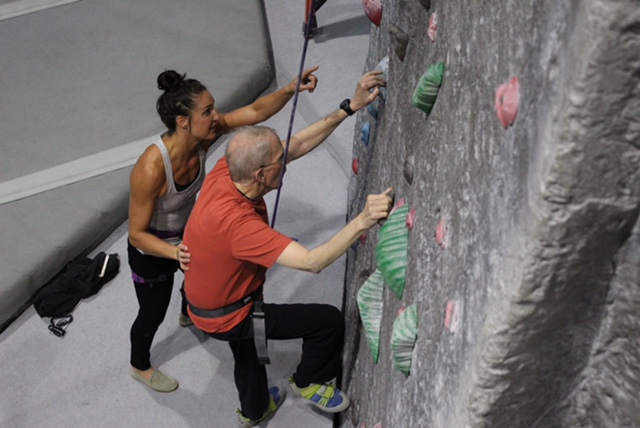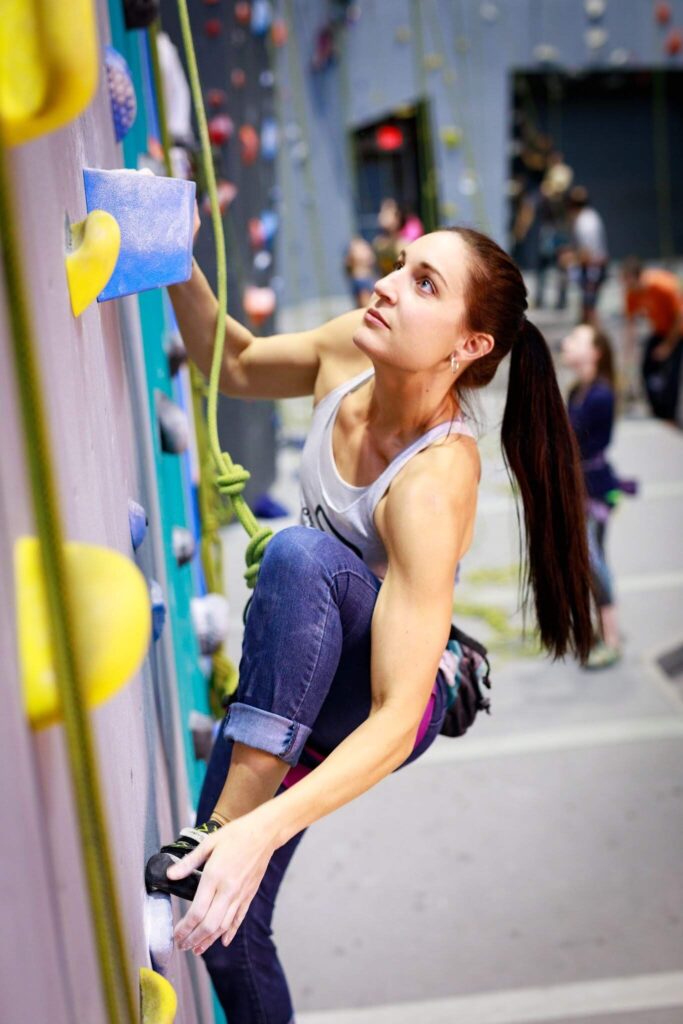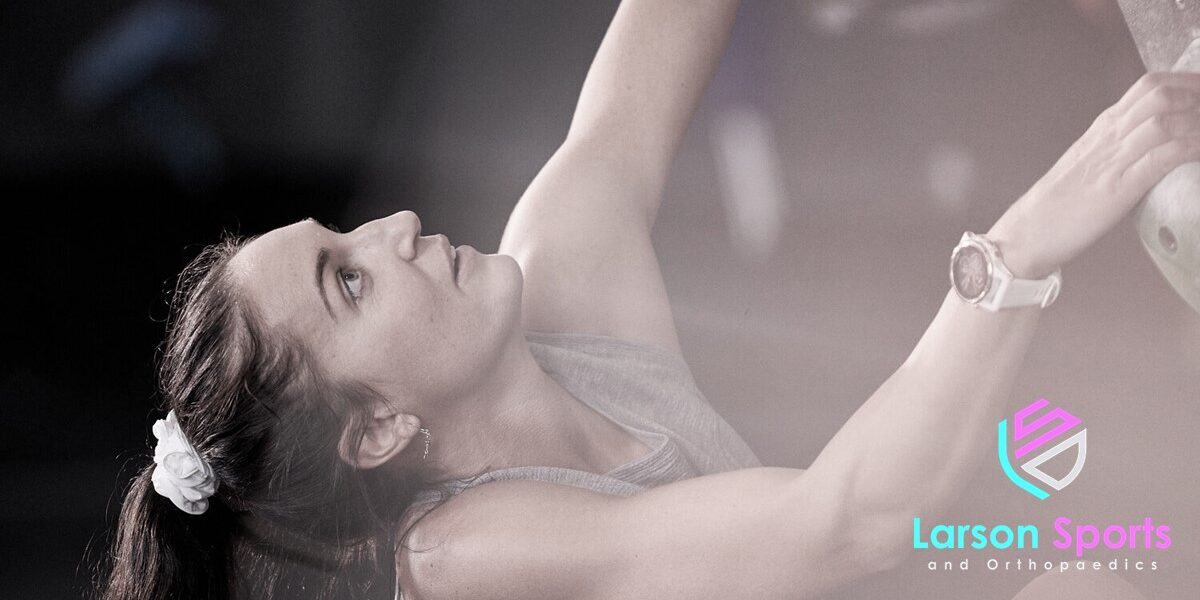Most of us would assume (rightly) that climbing is a great workout that strengthens your muscles and provides a lot of cardio while being very low impact. In fact, few exercises rival climbing in terms of the sheer number of muscles required. But what many people do not know is how impactful climbing can be on the health of your brain. Studies have been done that show that skilled sports, especially climbing, can increase and strengthen your motor cortex plasticity. Which makes climbing an excellent sport for people with Parkinson’s Disease.
Sounds a little crazy right? Well, my name is Molly Donelan and I’ve been teaching people with Parkinson’s how to climb safely for the last eight years. So I can tell you first-hand just how helpful and SAFE this form of exercise is for people with Parkinson’s Disease!

Molly is the Director of Events and programs at Sportrock Climbing Centers in Alexandria and Sterling, Virginia where she has been working and climbing for over 12 years. Molly was able to combine her love of climbing as well as her passion for neuroscience when she started a Parkinson’s climbing group at Sportrock 8 years ago. While she has participated in the first ever study in the United States on the benefits of climbing on Parkinson’s Disease, she hopes to participate in many more and hopefully one day get insurance companies to include climbing as a covered therapy for those living with Parkinson’s Disease.
Climbing Helps Retrain Your Brain
Climbing is a unique sport in the way that it combines analysis of a surface, planning of a route, and then the physical activity of enacting that plan. This requires constant feedback between your frontal lobe and the more posterior portions of the brain that turn your intention into actual movement.
Our body responds to the ways we train it and that includes the brain. By asking the brain to coordinate between the planning and execution areas, the brain will build more and stronger connections between those areas. And it can even “rewire” other parts of the brain to take over the job that damaged areas used to do.
How Climbing Helps Parkinson’s Disease
In Parkinson’s Disease, the neurons that normally coordinate between your motor cortex and your spinal cord slowly die off. That means it becomes difficult to translate intention into actual movement. And the motor cortex has a hard time “rewiring” to work around this. Neuroscience: Substantia Nigra.
While there is no sure way to cure this neurodegenerative disease, exercise unquestionably helps slow the process and give relief to some of the symptoms. In short, by repeatedly doing a highly skilled activity like climbing, we are increasing and strengthening the connections in our brain that help us move. Even the Department of Veteran’s Affairs recognizes that climbing can be very beneficial for people with a wide variety of movement disorders.

Teaching Parkinson’s Patients to Climb (And Soar!)
It was over 8 years ago when Jon Lessin first stepped into Sportrock. Jon is an accomplished doctor, published author, father, husband, cyclist, yogi, jokester, and most recently, an addicted climber. He also has Parkinson’s Disease. And Jon was “patient zero” to catch the “climbing bug” and my first experience working with anyone who had Parkinson’s Disease.
With a background and passion for Neurobiology, I was eager to see how climbing may help Jon and Jon was excited to try something new. The benefits were evident early on. Jon saw major improvements in not just his tremors and function, but his mood as well. Climbing can be an exhilarating sport, and even more so when you overcome the hurdles of Parkinson’s.
With the help of Sportrock and Jon, we started a free climbing session for people with Parkinson’s Disease and have grown the group tremendously. Sportrock Climbing Centers has even partnered with the Parkinson’s Foundation of the National Capital Area (PFNCA) to undertake the first-ever study in the United States on Parkinson’s Disease and Climbing with George Washington University. You can read the results of that study here: Impact of Rock Climbing on Complex Tasks in Persons with Parkinson’s Disease.
While this study was small, it corroborated what I suspected: climbing helps Parkinson’s patients! This study is hopefully a stepping stone for a larger, more comprehensive study to be done.
“Safer On Wall Than On The Floor”

Some people may think we were crazy for trying this. It may seem too dangerous. But after teaching people to climb for many years, that didn’t worry me at all. While climbing, these people are safely secured. If they slip, they safely swing away and then can be gently lowered by the belay. In fact, many of the climbers often mention they feel more secure climbing than they do simply walking from their car into the gym, where a fall could cause a real injury. We even have some clients that come to our facility in a wheelchair, but then climb the wall with relative ease!
Rock Climbing Improves Life With Parkinson’s Disease
Aside from the neuroplastic changes that occur in the brain, climbing is a uniquely beneficial sport for those living with Parkinson’s Disease. Researchers indicate that consistent exercise can slow the progression of the disease. The old saying “use it or lose it” really does apply to this disease.
- Rock climbing works the entire body, and has the potential to increase muscle mass and strength, improve balance, and enhance flexibility.
- It also employs the technique of weight shifting, something which is a specific difficulty for many living with Parkinson’s Disease. They have a hard time shifting their center of gravity from one side to the other while moving.
- It employs plenty of brightly colored handholds to provide visual cues. This helps reduce freezing and improves initiation of motion for those with Parkinson’s.
- It helps strengthen the neural connections between the cognitive areas of the brain and the motor coordinating areas.
- It’s a great cardiovascular workout, which can be very difficult for people with Parkinson’s to get regularly.
While you may expect to engage your muscles while climbing, it may come as a surprise at the level of cardio effort that is placed on your body, as well as cognitive involvement as you begin your ascent. Your mind actively seeks the next best move as your feet attempt to comply. And that forces your brain to find the best set of neurons to do the job. And the more you use a set of neurons, the stronger and healthier those cells and synapses become.
But don’t take my word for it. One of our biggest enthusiasts at Sportrock is Teresa Jackson. I’ll let her tell you how climbing has helped with her Parkinson’s Journey:
“After my Parkinson’s diagnosis, I was eager to find exercise programs that would help improve my strength and balance and would be fun while participating. Shortly after my initial diagnosis, I joined Rock Steady Boxing, which assisted me in making great strides with my strength, balance, and conditioning. I explored and participated in ballet, walked several miles per week, and worked with a personal trainer to ensure I did not lose any ground with my fitness.
Finding Out About Climbing
But I never considered rock climbing until I read the book Tenacity: A Memoir by Jonathan Lessin, the physician mentioned above, who shared his rock-climbing experience while living with Parkinson’s Disease. In late October of 2020, I picked up Jon’s book and began to read. As I rounded the corner of chapter 16 there it was: Jonathan Lessin, who was diagnosed with Parkinson’s Disease, was a rock climber. Rock climbing struck me as a sport where shear strength was needed to muscle your way up a wall.
I thought for sure that this sport was too difficult for me and I was not strong enough to tackle it even if I didn’t have Parkinson’s!
However, I was captivated as Jon described his experience with rock climbing, which was a sport he picked up after his diagnosis. He recounted trying to figure out the puzzle on the wall, engaging his brain to determine the route needed to ascend to the top. I was amazed to realize that it was this planning, more than strength alone, that allowed climbers to be successful. And it was this planning and execution that helped improve the symptoms of Parkinson’s.
A New Passion
Fascinated with this new perspective, I decided to reach out to a local climbing establishment, Sportrock Climbing Centers. It just so happened that this was where Jon climbed as well! This is where I met Molly. And that’s how I became hooked!
I’m so hooked that each Thursday I drive an hour and forty-five minute ONE WAY to meet with Molly and the other Parkinson’s climbers. I’m so thankful to Sportrock for donating their facilities and the instructors for donating their time!
As a novice climber, I was surprised by how numerous the benefits are. For me personally, rock climbing improved my strength and balance while also improving my flexibility. And the level of cardio demand came as a surprise to me as I ascended each climb. The benefits do not stop there! Some great friendships are formed; ones that encourage, uplift and motivate you on even your toughest days. And those can be pretty rough days otherwise as a person living with Parkinson’s. For me it’s a win/win every time I climb.”

Teresa Jackson is a Certified Integrative Health and Wellness coach trained by Duke University Integrative Medicine, where she helps her clients become more successful through improving their health and wellness. She is dedicated to improving patient education about living with Parkinson’s Disease. Tune in to her podcast “Parkinson’s Pathway Pals; Tuesdays With Teresa” or connect with her for health coaching on her website Lean On Me Coaching.
Try It Today!
Rock Climbing may seem intimidating at first, but we encourage you to try it, Parkinson’s Disease or not! This highly addictive sport will leave you exhilarated and wanting more! You will become addicted not only to the natural boost of endorphins, dopamine, and serotonin but also to the encouragement and camaraderie. And if you’re a bit nervous about the height… just don’t look down!
After all, we teach you not just to climb but to soar!
Contact Sportrock today if you live near Northern Virginia would like to participate in their classes.
(703) 212-7625
References
Imaging of Motor Cortex Physiology in Parkinson’s Disease
Can a Weekly Multi-Modal Exercise Class Preserve Motor and Non-Motor Function in Parkinson’s?

